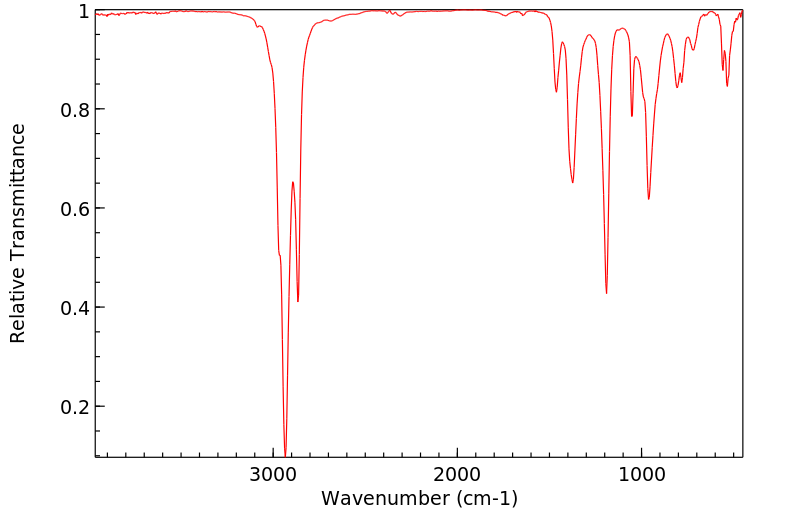tetradecyl mesylate | 6222-16-8
中文名称
——
中文别名
——
英文名称
tetradecyl mesylate
英文别名
tetradecyl methanesulfonate;Methansulfonsaeure-tetradecylester;Tetradecyl-methansulfonat
CAS
6222-16-8
化学式
C15H32O3S
mdl
——
分子量
292.483
InChiKey
SHHTUKUQKILIDO-UHFFFAOYSA-N
BEILSTEIN
——
EINECS
——
-
物化性质
-
计算性质
-
ADMET
-
安全信息
-
SDS
-
制备方法与用途
-
上下游信息
-
文献信息
-
表征谱图
-
同类化合物
-
相关功能分类
-
相关结构分类
物化性质
-
保留指数:2145
计算性质
-
辛醇/水分配系数(LogP):6.3
-
重原子数:19
-
可旋转键数:14
-
环数:0.0
-
sp3杂化的碳原子比例:1.0
-
拓扑面积:51.8
-
氢给体数:0
-
氢受体数:3
SDS
反应信息
-
作为反应物:描述:tetradecyl mesylate 在 sodium iodide 作用下, 以 丙酮 为溶剂, 反应 2.0h, 以70%的产率得到十四烷基碘化物参考文献:名称:用于基因传递的新型可生物降解吡啶两亲物摘要:可生物降解的合成阳离子吡啶基两亲物 (SAINT) 被证明是有前途的非病毒载体系统,用于将 DNA 递送到真核细胞中。以 3,5-吡啶二羧酸为起始材料合成了六种新型 SAINT,两个酯基团作为阳离子头部基团和疏水尾部之间的连接体。通过差示扫描量热法和透射电子显微镜研究了两亲物的囊泡形成特性,而通过核磁共振光谱研究了二酯在水中的水解。最后,在培养的 COS-7 和 HepG-2 细胞上测定转染潜力和细胞毒性。((C) Wiley-VCH Verlag GmbH & Co. KGaA, 2003)。DOI:10.1002/ejoc.200300361
-
作为产物:描述:参考文献:名称:天然烷基甘油的对映体合成及其抗菌和抗生物膜活性摘要:摘要 烷基甘油(AKGs)是通过烷基链长和不饱和度而变化的生物活性的天然化合物,它们的绝对构型为2小号。三个 AKGs ( 5l – 5n ) 以对映体纯的形式合成,并首次与其他 12 个已知和天然存在的 AKGs ( 5a – 5k , 5o )一起表征。它们的结构是使用1 H 和13 C APT NMR 与 2D-NMR、ESI-MS 或 HRESI-MS 和旋光数据建立的,并测试了它们的抗菌和抗生物膜活性。AKG 5a – 5m和5o对五种临床分离株和铜绿假单胞菌ATCC 15442显示出活性,MIC 值在 15–125 µg/mL 范围内。此外,在 MIC 的一半时,大多数 AKG 减少了 23%–99% 范围内的金黄色葡萄球菌生物膜形成和14%–64% 范围内的铜绿假单胞菌ATCC 15442 生物膜形成。在这项工作中评估的 AKG 的抗生物膜活性以前没有被研究过。DOI:10.1080/14786419.2019.1686370
-
作为试剂:描述:cis-tert-butyldimethyl(2-vinyl-1,3-dioxan-5-yloxy)silane 在 tetradecyl mesylate 作用下, 生成 2-(tert-Butyl-dimethyl-silanyloxy)-3-[((Z)-propenyl)oxy]-propan-1-ol参考文献:名称:一种高效的新的类脂型脂质途径:抗肿瘤醚脂类ET-18-OMe的质子胆碱类似物的合成和细胞毒性。摘要:DOI:10.1021/ja005522t
文献信息
-
[EN] CATIONIC LIPIDS AND USES THEREOF<br/>[FR] LIPIDES CATIONIQUES ET UTILISATIONS DE CEUX-CI申请人:ABBOTT LAB公开号:WO2009129385A1公开(公告)日:2009-10-22Cationic lipids, cationic lipid based drug delivery systems, ways to make them and methods of treating diseases using them are disclosed.阳离子脂质、基于阳离子脂质的药物传递系统、制备它们的方法以及利用它们治疗疾病的方法被披露。
-
Preparation and antitubercular activities of alkylated amino alcohols and their glycosylated derivatives作者:Aline F. Taveira、Mireille Le Hyaric、Elaine F.C. Reis、Débora P. Araújo、Ana Paula Ferreira、Maria Aparecida de Souza、Lívia L. Alves、Maria C.S. Lourenço、Felipe Rodrigues C. Vicente、Mauro V. de AlmeidaDOI:10.1016/j.bmc.2007.08.045日期:2007.12A series of N- and C-alkylated amino alcohols and of their protected galactopyranosyl derivatives was synthesized and evaluated for antitubercular activity. Five of these compounds displayed good activity, with a MIC below 12.5mug/mL. The presence of the carbohydrate slightly affected the antibacterial activity.
-
Ruthenium nanoparticle catalysts stabilized in phosphonium and imidazolium ionic liquids: dependence of catalyst stability and activity on the ionicity of the ionic liquid作者:Kylie L. Luska、Audrey MooresDOI:10.1039/c2gc35241a日期:——Ruthenium nanoparticles (Ru NPs) were synthesized from the reduction of Ru(2-methylallyl)2(cod) under an atmosphere of H2(g) in a series of phosphonium and imidazolium ionic liquids (ILs): [P4,4,4,1]NTf2, [P4,4,4,8]NTf2, [P4,4,4,14]X (for −X = −NTf2, −OTf, −PF6), [BMI]NTf2 and [BDMI]NTf2. The Ru NPs embedded in each of these ILs were used as biphasic hydrogenation catalysts for the reduction of cyclohexene钌 纳米粒子(Ru NPs)是在一系列磷鎓和咪唑鎓中,在H 2(g)气氛下,通过还原Ru(2-甲基烯丙基)2(cod)合成的离子液体(ILS):[P 4,4,4,1 ] NTF 2,[P 4,4,4,8 ] NTF 2,[P 4,4,4,14 ] X(为- X = - NTF 2,-光学传递函数,- PF 6),[BMI] NTF 2和[BDMI] NTF 2。嵌入在这些IL中的Ru NP被用作双相加氢催化剂 为了减少 环己烯。NP的性质,就NP稳定性和催化活性而言,取决于IL的性质,这些差异通过IL离子性的Walden图分析得以合理化。该分析支持以下观点:就离子对或超分子聚集体而言,离子缔合的形成在金属NP的IL稳定化中起关键作用。假设此稳定机制与NP稳定性和催化活性之间存在相关性。
-
[EN] ANTIVIRAL PRODRUGS, PHARMACEUTICAL FORMULATIONS, AND METHODS<br/>[FR] PROMÉDICAMENTS ANTIVIRAUX, FORMULATIONS PHARMACEUTIQUES ET MÉTHODES申请人:UNIV CALIFORNIA公开号:WO2022020793A1公开(公告)日:2022-01-27Compounds, including antiviral prodrugs, and pharmaceutical formulations including the compounds, which may be orally bioavailable or formulated for intramuscular injection. Methods for producing compounds, such as antiviral prodrugs. Methods for treating coronavirus and other RNA virus infection in mammals. Methods of producing a drug triphosphate.复合物,包括抗病毒的前药和药物配方,其中药物可以口服可吸收或制成肌肉注射剂。生产化合物的方法,例如抗病毒前药的生产方法。治疗哺乳动物的冠状病毒和其他RNA病毒感染的方法。生产药物三磷酸盐的方法。
-
Cationic Lipids and Uses Thereof申请人:Dande Prasad A.公开号:US20090263407A1公开(公告)日:2009-10-22Cationic lipids, cationic lipid based drug delivery systems, ways to make them and methods of treating diseases using them are disclosed.阳离子脂质、基于阳离子脂质的药物传递系统、制备它们的方法以及利用它们治疗疾病的方法被披露。
表征谱图
-
氢谱1HNMR
-
质谱MS
-
碳谱13CNMR
-
红外IR
-
拉曼Raman
-
峰位数据
-
峰位匹配
-
表征信息
同类化合物
高烯丙基(甲磺酰基)胺
高炔丙基(甲磺酰基)胺
顺式-9-十八碳烯基甲烷磺酸酯
顺式-4-乙基环己基甲烷磺酸酯
顺-1,2-双(甲磺酰基氧基甲基)环己烷
阿坎酸杂质
阿坎酸
锌甲烷磺酸盐
铵磺酸甜菜碱-3
铵磺酸甜菜碱-2
铵磺酸甜菜碱-1
铬雾抑制剂
铁三(三氟甲基磺酰基)亚胺
钾3-(三羟基硅烷基)-1-丙烷磺酸酯
钾1,1,2,2,3,3,4,4-八氟丁烷-1-磺酸盐
钡二乙烷磺酸酯
钠3-氨基丙烷磺酸酯
钠3-氨基-3-氧代-丙烷-1-磺酸酯
钠3-(三羟基硅烷基)-1-丙烷磺酸酯
钠2-[2-[2-[2-[2-[2-[2-[2-[2-[2-(2-十八碳-9-烯氧基乙氧基)乙氧基]乙氧基]乙氧基]乙氧基]乙氧基]乙氧基]乙氧基]乙氧基]乙氧基]-2-氧代-乙烷磺酸酯
钠1-羟基-1-庚烷磺酸酯
钠(1E)-1-十二碳烯-1-磺酸酯
酪朊酸钠
辛烷-1-磺酸甲酯
辛烷-1-磺酸乙酯
辛基-1-磺酸戊酯
辛-2-烯-1-磺酸
辅酶 M
西尼必利杂质7
萘-1,8-二甲醇
英丙舒凡对甲苯磺酸盐
英丙舒凡
苯基硒基三氟甲烷磺酸酯
芥酸酰胺丙基羟基磺基甜菜碱
艾日布林中间体
脒基牛磺酸
胺磺酸甜菜碱-4
联硫亚盐氯乙醛钠水合物
羧基-五聚乙二醇-磺酸
羟甲基磺酸钠
羟基甲烷磺酸铵盐
羟基甲烷磺酸钾
羟基甲氧基甲醇甲磺酸酯
羟乙磺酸钾
羟乙基磺酸铵盐
羟乙基磺酸钠
羟丙基硫代硫酸钠
美司那
磺酸钠
磺酸己烷







